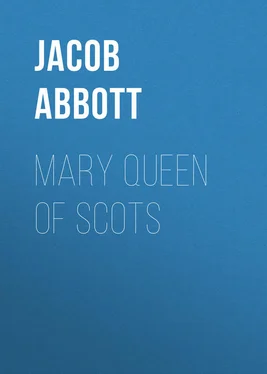Jacob Abbott - Mary Queen of Scots
Здесь есть возможность читать онлайн «Jacob Abbott - Mary Queen of Scots» — ознакомительный отрывок электронной книги совершенно бесплатно, а после прочтения отрывка купить полную версию. В некоторых случаях можно слушать аудио, скачать через торрент в формате fb2 и присутствует краткое содержание. ISBN: , Жанр: foreign_antique, foreign_prose, Историческая проза, на английском языке. Описание произведения, (предисловие) а так же отзывы посетителей доступны на портале библиотеки ЛибКат.
- Название:Mary Queen of Scots
- Автор:
- Жанр:
- Год:неизвестен
- ISBN:http://www.gutenberg.org/ebooks/28283
- Рейтинг книги:4 / 5. Голосов: 1
-
Избранное:Добавить в избранное
- Отзывы:
-
Ваша оценка:
- 80
- 1
- 2
- 3
- 4
- 5
Mary Queen of Scots: краткое содержание, описание и аннотация
Предлагаем к чтению аннотацию, описание, краткое содержание или предисловие (зависит от того, что написал сам автор книги «Mary Queen of Scots»). Если вы не нашли необходимую информацию о книге — напишите в комментариях, мы постараемся отыскать её.
Mary Queen of Scots — читать онлайн ознакомительный отрывок
Ниже представлен текст книги, разбитый по страницам. Система сохранения места последней прочитанной страницы, позволяет с удобством читать онлайн бесплатно книгу «Mary Queen of Scots», без необходимости каждый раз заново искать на чём Вы остановились. Поставьте закладку, и сможете в любой момент перейти на страницу, на которой закончили чтение.
Интервал:
Закладка:
Dumbarton Castle.
Rock of Dumbarton.
They bade their lonely island farewell, and traveled south till they came to a strong castle on a high, rocky hill, on the banks of the River Clyde. The name of this fortress is Dumbarton Castle. Almost all the castles of those times were built upon precipitous hills, to increase the difficulties of the enemies in approaching them. The Rock of Dumbarton is a very remarkable one. It stands close to the bank of the river. There are a great many ships and steam-boats continually passing up and down the Clyde, to and from the great city of Glasgow, and all the passengers on board gaze with great interest, as they sail by, on the Rock of Dumbarton, with the castle walls on the sides, and the towers and battlements crowning the summit. In Mary's time there was comparatively very little shipping on the river, but the French fleet was there, waiting opposite the castle to receive Mary and the numerous persons who were to go in her train. 2 2 Travelers who visit Scotland from this country at the present day, usually land first, at the close of the voyage across the Atlantic, at Liverpool, and there take a Glasgow steamer. Glasgow, which is the great commercial city of Scotland, is on the River Clyde. This river flows northward to the sea. The steamer, in ascending the river, makes its way with difficulty along the narrow channel, which, besides being narrow and tortuous, is obstructed by boats, ships, steamers, and every other variety of water-craft, such as are always going to and fro in the neighborhood of any great commercial emporium. The tourists, who stand upon the deck gazing at this exciting scene of life and motion, have their attention strongly attracted, about half way up the river, by this Castle of Dumbarton, which crowns a rocky hill, rising abruptly from the water's edge, on the north side of the stream. It attracts sometimes the more attention from American travelers, on account of its being the first ancient castle they see. This it likely to be the case if they proceed to Scotland immediately on landing at Liverpool.
Journey to Dumbarton.
The four Maries.
Departure from Scotland.
Mary was escorted from the island where she had been living, across the country to Dumbarton Castle, with a strong retinue. She was now between five and six years of age. She was, of course, too young to know any thing about the contentions and wars which had distracted her country on her account, or to feel much interest in the subject of her approaching departure from her native land. She enjoyed the novelty of the scenes through which she passed on her journey. She was pleased with the dresses and the arms of the soldiers who accompanied her, and with the ships which were floating in the river, beneath the walls of the Castle of Dumbarton, when she arrived there. She was pleased, too, to think that, wherever she was to go, her four Maries were to go with her. She bade her mother farewell, embarked on board the ship which was to receive her, and sailed away from her native land, not to return to it again for many years.
Chapter II
Her Education in France
Departure.
Stormy voyage.
The departure of Mary from Scotland, little as she was, was a great event both for Scotland and for France. In those days kings and queens were even of greater relative importance than they are now, and all Scotland was interested in the young queen's going away from them, and all France in expecting her arrival. She sailed down the Clyde, and then passed along the seas and channels which lie between England and Ireland. These seas, though they look small upon the map, are really spacious and wide, and are often greatly agitated by winds and storms. This was the case at the time Mary made her voyage. The days and nights were tempestuous and wild, and the ships had difficulty in keeping in each other's company. There was danger of being blown upon the coasts, or upon the rocks or islands which lie in the way. Mary was too young to give much heed to these dangers, but the lords and commissioners, and the great ladies who went to attend her, were heartily glad when the voyage was over. It ended safely at last, after several days of tossing upon the stormy billows, by their arrival upon the northern coast of France. They landed at a town called Brest.
Journey to Paris.
Release of prisoners.
Barabbas.
The King of France had made great preparations for receiving the young queen immediately upon her landing. Carriages and horses had been provided to convey herself and the company of her attendants, by easy journeys, to Paris. They received her with great pomp and ceremony at every town which she passed through. One mark of respect which they showed her was very singular. The king ordered that every prison which she passed in her route should be thrown open, and the prisoners set free. This fact is a striking illustration of the different ideas which prevailed in those days, compared with those which are entertained now, in respect to crime and punishment. Crime is now considered as an offense against the community , and it would be considered no favor to the community, but the reverse, to let imprisoned criminals go free. In those days, on the other hand, crimes were considered rather as injuries committed by the community, and against the king; so that, if the monarch wished to show the community a favor, he would do it by releasing such of them as had been imprisoned by his officers for their crimes. It was just so in the time of our Savior, when the Jews had a custom of having some criminal released to them once a year, at the Passover, by the Roman government, as an act of favor . That is, the government was accustomed to furnish, by way of contributing its share toward the general festivities of the occasion, the setting of a robber and a murderer at liberty!
St. Germain.
Celebrations.
The King of France has several palaces in the neighborhood of Paris. Mary was taken to one of them, named St. Germain. This palace, which still stands, is about twelve miles from Paris, toward the northwest. It is a very magnificent residence, and has been for many centuries a favorite resort of the French kings. Many of them were born in it. There are extensive parks and gardens connected with it, and a great artificial forest, in which the trees were all planted and cultivated like the trees of an orchard. Mary was received at this palace with great pomp and parade; and many spectacles and festivities were arranged to amuse her and the four Maries who accompanied her, and to impress her strongly with an idea of the wealth, and power, and splendor of the great country to which she had come.
The convent.
She remained here but a short time, and then it was arranged for her to go to a convent to be educated. Convents were in those days, as in fact they are now, quite famous as places of education. They were situated sometimes in large towns, and sometimes in secluded places in the country; but, whether in town or country, the inmates of them were shut up very strictly from all intercourse with the world. They were under the care of nuns who had devoted themselves for life to the service. These nuns were some of them unhappy persons, who were weary of the sorrows and sufferings of the world, and who were glad to retire from it to such a retreat as they fancied the convent would be. Others became nuns from conscientious principles of duty, thinking that they should commend themselves to the favor of God by devoting their lives to works of benevolence and to the exercises of religion. Of course there were all varieties of character among the nuns; some of them were selfish and disagreeable, others were benevolent and kind.
Character of the nuns.
Читать дальшеИнтервал:
Закладка:
Похожие книги на «Mary Queen of Scots»
Представляем Вашему вниманию похожие книги на «Mary Queen of Scots» списком для выбора. Мы отобрали схожую по названию и смыслу литературу в надежде предоставить читателям больше вариантов отыскать новые, интересные, ещё непрочитанные произведения.
Обсуждение, отзывы о книге «Mary Queen of Scots» и просто собственные мнения читателей. Оставьте ваши комментарии, напишите, что Вы думаете о произведении, его смысле или главных героях. Укажите что конкретно понравилось, а что нет, и почему Вы так считаете.












